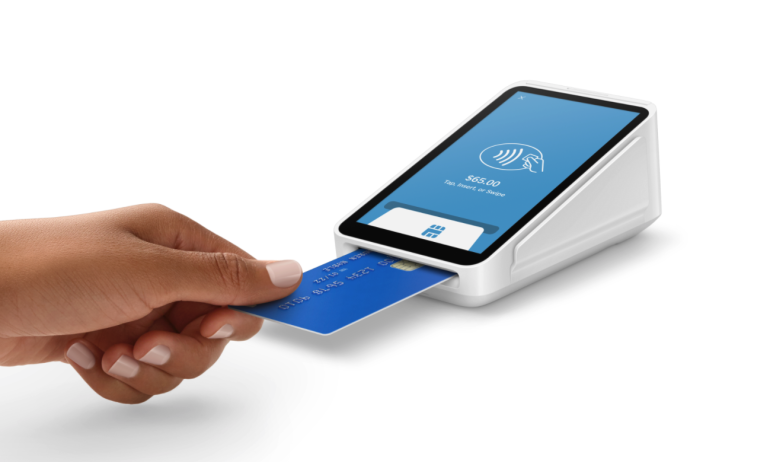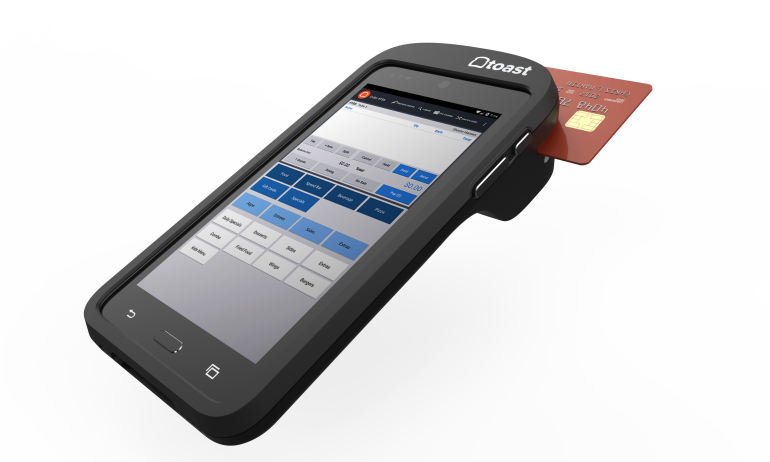| Product | Best for | NerdWallet rating | Payment processing fees | Monthly fee | Learn more |
|---|---|---|---|---|---|
| Overall bar POS system | In-person: 2.6% + $0.15 Online: 3.3% + $0.30 | $0 Free plan; $49 Plus plan; $149 Premium plan. | on Square's website | ||
| Bars that serve food | 2.49% + $0.15 if you buy hardware upfront; 3.09% + $0.15 for pay-as-you-go option. | $0 Starter Kit; $69 Point of Sale plan; custom Build Your Own plan. | on Toast's website | ||
| Customer engagement tools | In-person: 2.3% + $0.10 Online: 3.5% + $0.10 | $0 and up. | on Clover's website | ||
| Flexibility and customizability | In-person: 2.6% + $0.10 Online: 2.9% + $0.30 | $189 $399 Premium plan. | on Lightspeed's website | ||
| System reliability | N/A Quote-based. | $69 and up. | on TouchBistro's website |
Square Restaurant POS
Best for Overall bar POS system
Online: 3.3% + $0.30
Free plan; $49 Plus plan; $149 Premium plan.
on Square's website
Pros
- Free plan available.
- App and card readers are compatible with iOS and Android devices.
- Can pay for hardware in installments.
- No long-term contracts or installation fees.
- In-house payroll software available.
- All plans include a free online ordering page.
Cons
- Free plan doesn’t include 24/7 support.
- Free plan processing rates are more expensive than competitors.
Toast POS
Best for Bars that serve food
if you buy hardware upfront; 3.09% + $0.15 for pay-as-you-go option.
Starter Kit; $69 Point of Sale plan; custom Build Your Own plan.
on Toast's website
Pros
- Free plan available for restaurants with up to two POS terminals.
- 24/7 phone and web messaging support.
- Offers helpful related services, like payroll and team management software, that integrate closely with its POS system.
- Built specifically for restaurants with in-house delivery platform available, among other industry-specific features.
Cons
- Requires a two-year contract and charges early termination fees.
- Online payment processing rates are more expensive than competitors.
- Charges setup fee, and offline mode includes hidden cost of backup router.
- Online ordering and accounting integrations cost extra.
Clover POS
Best for Customer engagement tools
Online: 3.5% + $0.10
and up.
on Clover's website
Pros
- Free plan available if you’re only using a mobile card reader.
- 24/7 phone support.
- All restaurant plans include no-fee online ordering, and retail plans let you integrate with existing online stores.
- Offers a variety of plans tailored to six specific types of businesses.
- Can pair POS systems with third-party payment processors.
Cons
- Promotions require a three-year contract.
- May be subject to early termination fees if you use Clover as your payment processor.
- Online payment processing rates are more expensive than competitors.
Lightspeed Restaurant POS
Best for Flexibility and customizability
Online: 2.9% + $0.30
$399 Premium plan.
on Lightspeed's website
Pros
- Offers advanced inventory management and recipe costing tools.
- All plans include CRM and loyalty programs.
- Essential and Premium plans include one-on-one support.
- 24/7 support available.
Cons
- Syncing with accounting software costs extra.
- Some plans may require long-term contracts.
- Lowest-tier plan is more expensive than competitors.
TouchBistro
Best for System reliability
Quote-based.
and up.
on TouchBistro's website
Pros
- 24/7 phone, chat and email support.
- Includes restaurant-specific features, like table and menu management.
- Optional profit management system provides tools for improving margins.
- As a hybrid POS system, TouchBistro can operate without the cloud. Offline capabilities include accepting payments, taking orders, editing menus and managing staff.
Cons
- Payment processing rates are quote-based, making them difficult to compare to the competition.
- Contracts are automatically renewed and can't be terminated early.
- No free plan options and charges setup fee.
- Ability to accept online orders costs extra.
Online: 3.3% + $0.30
Free plan; $49 Plus plan; $149 Premium plan.
on Square's website
Pros
- Free plan available.
- App and card readers are compatible with iOS and Android devices.
- Can pay for hardware in installments.
- No long-term contracts or installation fees.
- In-house payroll software available.
- All plans include a free online ordering page.
Cons
- Free plan doesn’t include 24/7 support.
- Free plan processing rates are more expensive than competitors.
Square Restaurant POS
Best for Overall bar POS system
Best for Overall bar POS system
Online: 3.3% + $0.30
Free plan; $49 Plus plan; $149 Premium plan.
on Square's website
Pros
- Free plan available.
- App and card readers are compatible with iOS and Android devices.
- Can pay for hardware in installments.
- No long-term contracts or installation fees.
- In-house payroll software available.
- All plans include a free online ordering page.
Cons
- Free plan doesn’t include 24/7 support.
- Free plan processing rates are more expensive than competitors.
if you buy hardware upfront; 3.09% + $0.15 for pay-as-you-go option.
Starter Kit; $69 Point of Sale plan; custom Build Your Own plan.
on Toast's website
Pros
- Free plan available for restaurants with up to two POS terminals.
- 24/7 phone and web messaging support.
- Offers helpful related services, like payroll and team management software, that integrate closely with its POS system.
- Built specifically for restaurants with in-house delivery platform available, among other industry-specific features.
Cons
- Requires a two-year contract and charges early termination fees.
- Online payment processing rates are more expensive than competitors.
- Charges setup fee, and offline mode includes hidden cost of backup router.
- Online ordering and accounting integrations cost extra.
Toast POS
Best for Bars that serve food
Best for Bars that serve food
if you buy hardware upfront; 3.09% + $0.15 for pay-as-you-go option.
Starter Kit; $69 Point of Sale plan; custom Build Your Own plan.
on Toast's website
Pros
- Free plan available for restaurants with up to two POS terminals.
- 24/7 phone and web messaging support.
- Offers helpful related services, like payroll and team management software, that integrate closely with its POS system.
- Built specifically for restaurants with in-house delivery platform available, among other industry-specific features.
Cons
- Requires a two-year contract and charges early termination fees.
- Online payment processing rates are more expensive than competitors.
- Charges setup fee, and offline mode includes hidden cost of backup router.
- Online ordering and accounting integrations cost extra.
Online: 3.5% + $0.10
and up.
on Clover's website
Pros
- Free plan available if you’re only using a mobile card reader.
- 24/7 phone support.
- All restaurant plans include no-fee online ordering, and retail plans let you integrate with existing online stores.
- Offers a variety of plans tailored to six specific types of businesses.
- Can pair POS systems with third-party payment processors.
Cons
- Promotions require a three-year contract.
- May be subject to early termination fees if you use Clover as your payment processor.
- Online payment processing rates are more expensive than competitors.
Clover POS
Best for Customer engagement tools
Best for Customer engagement tools
Online: 3.5% + $0.10
and up.
on Clover's website
Pros
- Free plan available if you’re only using a mobile card reader.
- 24/7 phone support.
- All restaurant plans include no-fee online ordering, and retail plans let you integrate with existing online stores.
- Offers a variety of plans tailored to six specific types of businesses.
- Can pair POS systems with third-party payment processors.
Cons
- Promotions require a three-year contract.
- May be subject to early termination fees if you use Clover as your payment processor.
- Online payment processing rates are more expensive than competitors.
Online: 2.9% + $0.30
$399 Premium plan.
on Lightspeed's website
Pros
- Offers advanced inventory management and recipe costing tools.
- All plans include CRM and loyalty programs.
- Essential and Premium plans include one-on-one support.
- 24/7 support available.
Cons
- Syncing with accounting software costs extra.
- Some plans may require long-term contracts.
- Lowest-tier plan is more expensive than competitors.
Lightspeed Restaurant POS
Best for Flexibility and customizability
Best for Flexibility and customizability
Online: 2.9% + $0.30
$399 Premium plan.
on Lightspeed's website
Pros
- Offers advanced inventory management and recipe costing tools.
- All plans include CRM and loyalty programs.
- Essential and Premium plans include one-on-one support.
- 24/7 support available.
Cons
- Syncing with accounting software costs extra.
- Some plans may require long-term contracts.
- Lowest-tier plan is more expensive than competitors.
Pros
- 24/7 phone, chat and email support.
- Includes restaurant-specific features, like table and menu management.
- Optional profit management system provides tools for improving margins.
- As a hybrid POS system, TouchBistro can operate without the cloud. Offline capabilities include accepting payments, taking orders, editing menus and managing staff.
Cons
- Payment processing rates are quote-based, making them difficult to compare to the competition.
- Contracts are automatically renewed and can't be terminated early.
- No free plan options and charges setup fee.
- Ability to accept online orders costs extra.
TouchBistro
Best for System reliability
Best for System reliability
Quote-based.
and up.
on TouchBistro's website
Pros
- 24/7 phone, chat and email support.
- Includes restaurant-specific features, like table and menu management.
- Optional profit management system provides tools for improving margins.
- As a hybrid POS system, TouchBistro can operate without the cloud. Offline capabilities include accepting payments, taking orders, editing menus and managing staff.
Cons
- Payment processing rates are quote-based, making them difficult to compare to the competition.
- Contracts are automatically renewed and can't be terminated early.
- No free plan options and charges setup fee.
- Ability to accept online orders costs extra.
Jump to
Best bar POS systems: additional details
Square
- $0 for Square Free plan.
- $49 for Square Plus plan.
- $149 for Square Premium plans.
- $0 for Square magstripe-only card reader ($10 for each additional reader) or if using Tap to Pay for iPhone (iPhone not included).
- $59 for Square Reader contactless and chip card reader.
- $149 for Square Stand iPad POS or Square Stand Mount (iPad not included; monthly financing available).
- $149 for Square Kiosk for self-serve ordering.
- $299 for Square Terminal mobile card reader with built-in printer (monthly financing available).
- $399 for Square Handheld portable POS system with built-in barcode scanner (monthly financing available).
- $799 for Square Register two-screen system (monthly financing available).
- 2.6% plus 15 cents for in-person transactions with Free plan.
- 3.3% plus 30 cents for online transactions with Free plan.
- 2.5% plus 15 cents for in-person transactions with Plus plan.
- 2.4% plus 15 cents for in-person transaction with Premium plan.
- 2.9% plus 30 cents for online transactions with Plus and Premium plans.
- 3.5% plus 15 cents for manually keyed transactions.

Source: YouTube

Source: YouTube

Source: Square
Toast
- $0 for Starter Kit plan.
- $69 Point of Sale plan.
- Custom plans available.
- $494.10 for Handheld Starter Kit (but $0 if you agree to a higher processing fee).
- $1,123.20 for Countertop Starter Kit (but $0 if you agree to a higher processing fee).
- $1,438.20 for Guest Self-Service Starter Kit (but $0 if you agree to a higher processing fee).
- 3.09-3.69% plus 15 cents per transaction, if you choose a pay-as-you-go plan.
- 2.49% plus 15 cents for card-present transactions, if you pay for hardware upfront.
- 3.50% plus 15 cents for card-not-present transactions, if you pay for hardware upfront.

Source: YouTube

Source: YouTube

Source: Toast
Clover
- $0 for Clover Go Starter, Retail Basic and Personal Services Basic plans.
- $29.95 for Clover Go Essentials, Professional Services Basic, Home and Field Services Starter and Standard plans.
- $84.95 for Retail Standard and Professional, Personal Services Standard and Advanced, and Home & Field Services Advanced plans.
- $89.95 for Full-Service Dining Starter and Quick-Service Dining Starter and Standard plans.
- $104.90 for Retail Advanced plan.
- $109.90 for Full-Service Dining Standard and Quick-Service Dining Advanced plans.
- $129.85 for Full-Service Dining Advanced plan.
- $199 for chip, swipe and contactless Clover Go card reader.
- $349 for countertop card reader.
- $749 for Clover Flex mobile POS with receipt printer.
- $699 for slimmer Flex Pocket with no printer.
- $849 for Clover Mini POS.
- $799-$899 + $25 per month for kitchen display system.
- $1,799 for Clover Station Solo.
- $1,899 for Clover Station Duo.
- $3,499 + $34.95 per month for self-ordering kiosk.
- 2.3% plus 10 cents for in-person transactions on Full-Service and Quick-Service Restaurant plans.
- 2.5% plus 10 cents for in-person transactions on all Retail plans, Professional Services Standard and Advanced plans, all Personal Services plans and the Home and Field Services Advanced plan.
- 2.6% plus 10 cents for in-person transactions on the Home and Field Services Standard plan.
- 3.5% plus 10 cents for online or keyed-in transactions.

Source: YouTube

Source: Clover
Lightspeed Restaurant
- $69 for Starter plan.
- $189 for Essential plan.
- $399 for Premium plan.
- $79 for Mobile Tap V2 card reader.
- $199 for iPad swivel stand.
- $329 for WisePOS E countertop reader.
- $429 for Lightspeed Lite Server for data backup and offline mode functionality.
- 2.6% plus 10 cents per in-person transaction.
- 2.9% plus 30 cents for online transactions.

Source: YouTube

Source: YouTube
TouchBistro
- $69 and up for base plan.
- Additional features (e.g., gift cards, online ordering, loyalty program, reservations and marketing) are quote-based.

Source: YouTube
Bar POS system must-have features
- Speed and reliability. The bar environment is a fast-paced one, and you’ll need a POS system that can keep up on all fronts, from app and software response to payment processing to receipt printing. Taking advantage of a free trial opportunity or live, in-person demo could help you gauge whether the system you’re considering will power through a late-night rush or drag you down with delays and lag times.
- User friendliness. Even if you’re a tech-savvy business owner, your staff will likely have varying degrees of comfort with tech and POS systems. And because time is definitely money in the bar and restaurant industry, you want to be sure you won’t need to invest heavily in getting you and your staff confident in using the system. This is where POS providers who offer live setup and training support (especially if it’s in-person and most especially if it’s free) can stand out among the competition.
- 24/7 live support. Whether by phone or through chat, customer support availability — particularly after normal business hours — is an important consideration when choosing your bar POS provider. It’s great to have a chatbot at your fingertips for quick questions that can be easily answered, but when it’s 1 a.m. and your bar is packed, you won’t want to dampen the mood if your system suddenly has an issue accepting credit card payments and you’re unable to reach a customer support representative until 9 a.m. the next day.
- Tabs, split checks and promos. Customers will almost certainly expect the ability to open a tab, split a check among friends or coworkers and see what’s on offer for happy hour. You’ll want to be sure your POS system can deliver on those expectations.
- Menu management. Whether you have a small, curated menu of specialty cocktails, an extensive beer and food menu that spans several pages, or something in between, you’re going to need the ability to easily make changes to your menu. Some systems allow you to schedule pricing changes to occur on certain days and times (think happy hours and promotions), which can help to streamline your menu management.
- Staff management. Any bar owner knows the amount of time and thought that goes into creating a staffing schedule that satisfies both the employee and the business needs. Not to mention how crucial it is to accurately track and pay out tips, ensure employees get paid correctly and on time and set system permissions according to employee role. A POS system that includes functionality for managing staff, whether as a built-in feature or an add-on tool, is a must.
- Inventory tracking. It almost goes without saying that accurate
inventory tracking






